Placement Practice | Graphs - II
- Prateek Chauhan

- Jul 19, 2020
- 6 min read
In this blog, you will learn about traversals in graphs. Before that, you can go through an introduction to graphs.
Breadth-First Traversal of Graph
First of all, Traversal means visiting all the nodes of a graph.
Breadth-first traversal (BFS) is a recursive algorithm for searching all the vertices of a graph or a tree data structure.
BFS traversal of a graph is similar to that of the Level Order Traversal of Trees.
Algorithm:
The BFS traversal of Graphs also traverses the graph in levels.
The objective of the algorithm is to make each vertex as visited while avoiding cycles.
It puts each vertex of the graph into one of two categories:
Visited
Not Visited
The algorithm works as follows:
Start by putting any one of the graph's vertices at the back of a queue.
Take the front item of the queue and add it to the visited list.
Create a list of that vertex's adjacent nodes. Add the ones which aren't in the visited list to the back of the queue.
Keep repeating steps 2 and 3 until the queue is empty.
The graph might have two different disconnected parts so to make sure that we cover every vertex, we can also run the BFS algorithm on every node
Illustration:

We start from vertex 0, the BFS algorithm starts by putting it in the Visited list and putting all its adjacent vertices in the stack.
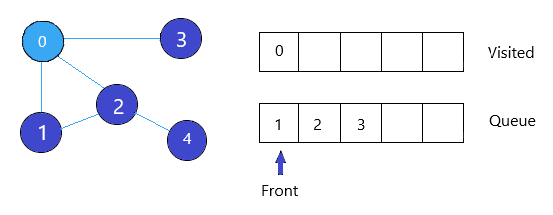
Next, we visit the element at the front of the queue i.e. 1, and go to its adjacent nodes. Since 0 has already been visited, we visit 2 instead.

Vertex 2 has an unvisited adjacent vertex in 4, so we add that to the back of the queue and visit 3, which is at the front of the queue.
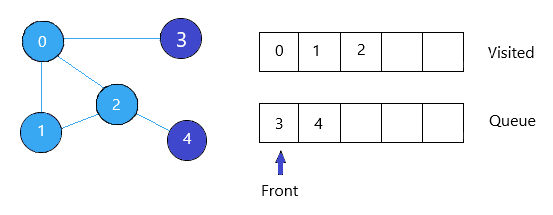
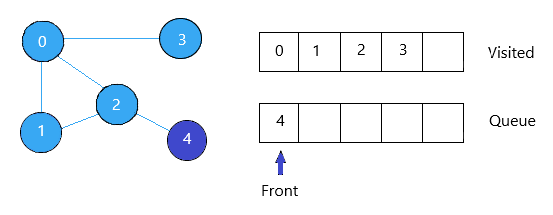
Only 4 remains in the queue since the only adjacent node of 3 i.e. 0 is already visited. We visit it.

Implementation using C:
#include <stdio.h>
#include <stdlib.h>
#define SIZE 40
struct queue {
int items[SIZE];
int front;
int rear;
};
struct queue* createQueue();
void enqueue(struct queue* q, int);
int dequeue(struct queue* q);
void display(struct queue* q);
int isEmpty(struct queue* q);
void printQueue(struct queue* q);
struct node {
int vertex;
struct node* next;
};
struct node* createNode(int);
struct Graph {
int numVertices;
struct node** adjLists;
int* visited;
};
// BFS algorithm
void bfs(struct Graph* graph, int startVertex) {
struct queue* q = createQueue();
graph->visited[startVertex] = 1;
enqueue(q, startVertex);
while (!isEmpty(q)) {
printQueue(q);
int currentVertex = dequeue(q);
printf("Visited %d\n", currentVertex);
struct node* temp = graph->adjLists[currentVertex];
while (temp) {
int adjVertex = temp->vertex;
if (graph->visited[adjVertex] == 0) {
graph->visited[adjVertex] = 1;
enqueue(q, adjVertex);
}
temp = temp->next;
}
}
}
// Creating a node
struct node* createNode(int v) {
struct node* newNode = malloc(sizeof(struct node));
newNode->vertex = v;
newNode->next = NULL;
return newNode;
}
// Creating a graph
struct Graph* createGraph(int vertices) {
struct Graph* graph = malloc(sizeof(struct Graph));
graph->numVertices = vertices;
graph->adjLists = malloc(vertices * sizeof(struct node*));
graph->visited = malloc(vertices * sizeof(int));
int i;
for (i = 0; i < vertices; i++) {
graph->adjLists[i] = NULL;
graph->visited[i] = 0;
}
return graph;
}
// Add edge
void addEdge(struct Graph* graph, int src, int dest) {
// Add edge from src to dest
struct node* newNode = createNode(dest);
newNode->next = graph->adjLists[src];
graph->adjLists[src] = newNode;
// Add edge from dest to src
newNode = createNode(src);
newNode->next = graph->adjLists[dest];
graph->adjLists[dest] = newNode;
}
// Create a queue
struct queue* createQueue() {
struct queue* q = malloc(sizeof(struct queue));
q->front = -1;
q->rear = -1;
return q;
}
// Check if the queue is empty
int isEmpty(struct queue* q) {
if (q->rear == -1)
return 1;
else
return 0;
}
// Adding elements into queue
void enqueue(struct queue* q, int value) {
if (q->rear == SIZE - 1)
printf("\nQueue is Full!!");
else {
if (q->front == -1)
q->front = 0;
q->rear++;
q->items[q->rear] = value;
}
}
// Removing elements from queue
int dequeue(struct queue* q) {
int item;
if (isEmpty(q)) {
printf("Queue is empty");
item = -1;
} else {
item = q->items[q->front];
q->front++;
if (q->front > q->rear) {
printf("Resetting queue ");
q->front = q->rear = -1;
}
}
return item;
}
// Print the queue
void printQueue(struct queue* q) {
int i = q->front;
if (isEmpty(q)) {
printf("Queue is empty");
} else {
printf("\nQueue contains \n");
for (i = q->front; i < q->rear + 1; i++) {
printf("%d ", q->items[i]);
}
}
}
int main() {
struct Graph* graph = createGraph(6);
addEdge(graph, 0, 1);
addEdge(graph, 0, 2);
addEdge(graph, 1, 2);
addEdge(graph, 1, 4);
addEdge(graph, 1, 3);
addEdge(graph, 2, 4);
addEdge(graph, 3, 4);
bfs(graph, 0);
return 0;
}The time complexity of the BFS algorithm is O(V + E) where V is the number of nodes and E is the number of edges.
Depth-First Traversal of Graph
Depth-first traversal (DFS) is a recursive algorithm for searching all the vertices of a graph or tree data structure.
In this traversal method, we start traversing the graph from a node and keep on going in the same direction as far as possible.
When no nodes are left to be traversed along the current path, backtrack to find a new possible path and repeat this process until all of the nodes are visited.
While performing the traversal the graph may contain a cycle and the same node can be visited again, so in order to avoid this, we can keep track of visited array using an auxiliary array.
On each step of the recursion mark, the current vertex visited, call the recursive function again for all the adjacent vertices.
Algorithm:
The objective of the algorithm is to mark each vertex as visited while avoiding cycles.
It puts each vertex of the graph into one of two categories:
Visited
Not Visited
The DFS algorithm works as follows:
Start by putting any one of the graph's vertices on top of a stack.
Take the top item of the stack and add it to the visited list.
Create a list of that vertex's adjacent nodes. Add the ones which aren't in the visited list to the top of the stack.
Keep repeating steps 2 and 3 until the stack is empty.
Illustration:
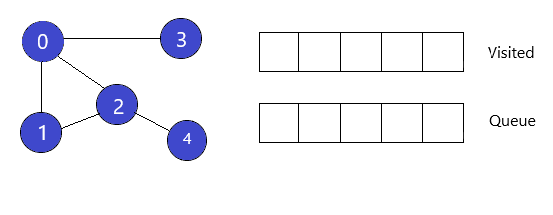
We start from vertex 0, the DFS algorithm starts by putting it in the Visited list and putting all its adjacent vertices in the stack.
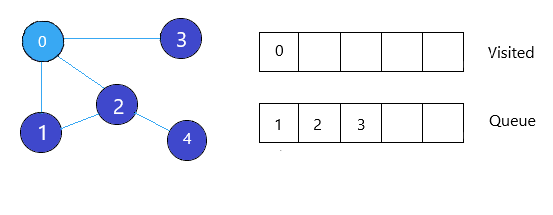
Next, we visit the element at the top of stack i.e. 1 and go to its adjacent nodes. Since 0 has already been visited, we visit 2 instead.

Vertex 2 has an unvisited adjacent vertex in 4, so we add that to the top of the stack and visit it.
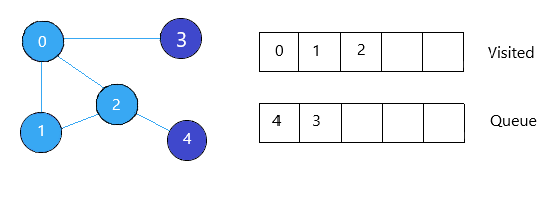
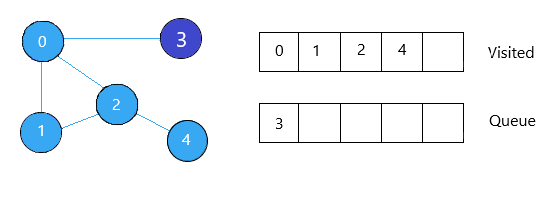
After we visit the last element 3, it doesn't have any unvisited adjacent nodes, so we have completed the Depth First Traversal of the graph.
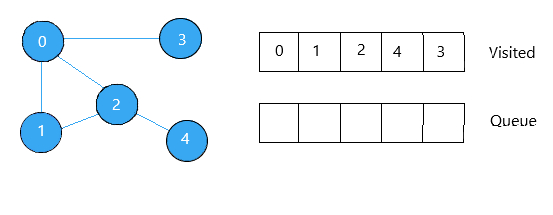
Implementation using C:
#include <stdio.h>
#include <stdlib.h>
struct node {
int vertex;
struct node* next;
};
struct node* createNode(int v);
struct Graph {
int numVertices;
int* visited;
struct node** adjLists;
};
void DFS(struct Graph* graph, int vertex) {
struct node* adjList = graph->adjLists[vertex];
struct node* temp = adjList;
graph->visited[vertex] = 1;
printf("Visited %d \n", vertex);
while (temp != NULL) {
int connectedVertex = temp->vertex;
if (graph->visited[connectedVertex] == 0) {
DFS(graph, connectedVertex);
}
temp = temp->next;
}
}
struct node* createNode(int v) {
struct node* newNode = malloc(sizeof(struct node));
newNode->vertex = v;
newNode->next = NULL;
return newNode;
}
struct Graph* createGraph(int vertices) {
struct Graph* graph = malloc(sizeof(struct Graph));
graph->numVertices = vertices;
graph->adjLists = malloc(vertices * sizeof(struct node*));
graph->visited = malloc(vertices * sizeof(int));
int i;
for (i = 0; i < vertices; i++) {
graph->adjLists[i] = NULL;
graph->visited[i] = 0;
}
return graph;
}
void addEdge(struct Graph* graph, int src, int dest) {
struct node* newNode = createNode(dest);
newNode->next = graph->adjLists[src];
graph->adjLists[src] = newNode;
newNode = createNode(src);
newNode->next = graph->adjLists[dest];
graph->adjLists[dest] = newNode;
}
void printGraph(struct Graph* graph) {
int v;
for (v = 0; v < graph->numVertices; v++) {
struct node* temp = graph->adjLists[v];
printf("\n Adjacency list of vertex %d\n ", v);
while (temp) {
printf("%d -> ", temp->vertex);
temp = temp->next;
}
printf("\n");
}
}
int main() {
struct Graph* graph = createGraph(4);
addEdge(graph, 0, 1);
addEdge(graph, 0, 2);
addEdge(graph, 1, 2);
addEdge(graph, 2, 3);
printGraph(graph);
DFS(graph, 2);
return 0;
}The time complexity of the DFS algorithm is represented in the form of O(V + E).
The space complexity of the algorithm is O(V).
Happy Coding!
Follow us on Instagram @programmersdoor
Join us on Telegram @programmersdoor
Please write comments if you find any bug in the above code/algorithm, or find other ways to solve the same problem.
Follow Programmers Door for more.
.png)



Comments